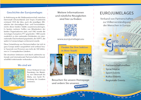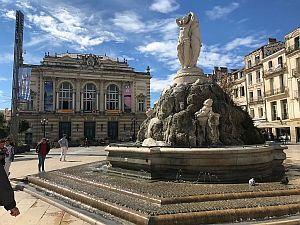2021: French language course at Montpellier
Finally, the French language course in Montpellier from 18th - 25th September 2021 could take place! The language course had been postponed for a year because of Corona. Not all participants from Germany and Spain came who were planning to do so in 2019.
The event was carried out under the strictest French Corona regulations. In the hotel, in all restaurants and indoors, the pass sanitaire was checked and a mask had to be worn. All were vaccinated and this gave us optimal Covid security.
On Saturday evening, Marie-Hélène, the organizer of the language course, warmly welcomed every one of us who arrived one after the other either by car, train or plane at the centrally located 3-star Hotel Kyriad. Everyone already knew some of the twinners and you got to know the others better and better at dinners and during the week. There were 12 French learners from Germany, 1 from Denmark and 7 from Spain. During the week we were caringly accompanied through the entire weekly cultural program by some twinners from Narbonne, Marseille and Paris.
We were able to demonstrate or apply our existing French language skills or those we had learned in the course of the days during the current afternoon programme. When communicating with each other, we often used all the languages available - German-French-Spanish-English. We were united by our common bond through Eurojumelages and we wanted to communicate with each other. At this point, the President of Narbonne Marie-Hélène deserves great praise for her perfect organizational skills and, above all, for her well-planned, varied cultural programme.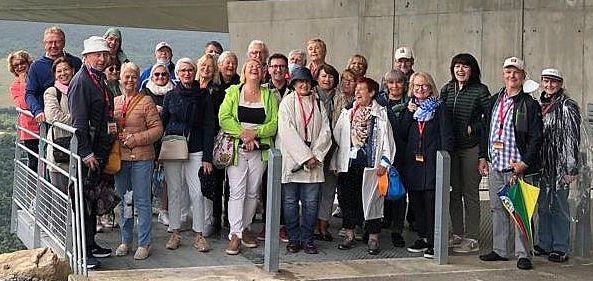 Sunday
Sunday
On Sunday morning, in fine weather, we took the coach to Millau at 8 o'clock to admire a masterpiece of modern bridge construction - the “Viaduc de Millau”. This bridge is the longest cable-stayed bridge with the highest bridge piers in the world. This bridge construction was very important to facilitate the transport connection between Béziers/Montpellier towards Clermont-Ferrand. The impetus for its construction was the precarious 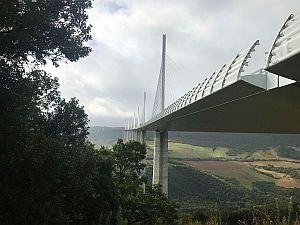 traffic situation. Now the bridge with its impressive architecture spans the valley of the small river Tarn for almost two and a half kilometers. After 20 years of planning and only 3 years of construction, the Millau Viaduct was inaugurated in 2004. The French are very proud of the filigree building by the British architect Sir Norman Forster and the French civil engineer Michel Virlogeux. This sight was brought closer to us by a detailed guided tour - extremely impressive. This building has helped the structurally weak region to an economic upswing.
traffic situation. Now the bridge with its impressive architecture spans the valley of the small river Tarn for almost two and a half kilometers. After 20 years of planning and only 3 years of construction, the Millau Viaduct was inaugurated in 2004. The French are very proud of the filigree building by the British architect Sir Norman Forster and the French civil engineer Michel Virlogeux. This sight was brought closer to us by a detailed guided tour - extremely impressive. This building has helped the structurally weak region to an economic upswing.
Unfortunately, we couldn't take the sun from Montpellier with us on this day, the weather - as is typical for this region - showed its changeable side with lots of rain and wind.
After a traditional lunch in Millau, we went to Roquefort-sur-Soulzon by coach to visit the place of origin of the famous Roquefort cheese. A guide accompanied us through the unique cave cellars and explained the prehistory and the production of the cheese. Roquefort is made from raw sheep's milk. The caves behind the village of Roquefort-sur-Soulzon, which are essential for the maturation of Roquefort, are of natural origin and some have been used unchanged since the 17th century. The entire cave system extends over a length of 2 km, a width of 300 m and the same depth. There is a temperature of approx. 10 ° C and a humidity of 90%. Air exchange takes place through long, narrow crevices in the rock, so-called “fleurines”, which the cheese master can open or 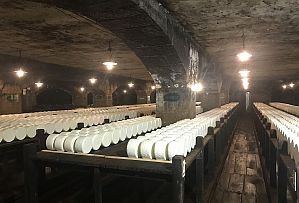 close with the help of doors or windows. A perfectly adapted microorganism has developed in this natural habitat: the Penicillium Roqueforti. The sheep's milk is inoculated with Penicillium Roqueforti when the cheese is made in the dairy and then brought to the cave cellars to mature. The Roquefort then matures in the caves for about three weeks. Afterwards, the loaves are wrapped in a special foil and ripen for another 3 to 12 months in darker and cooler parts of the caves. During the following tasting, we could try 3 different quality and taste levels of Société Roquefort and experience and enjoy the different flavours.
close with the help of doors or windows. A perfectly adapted microorganism has developed in this natural habitat: the Penicillium Roqueforti. The sheep's milk is inoculated with Penicillium Roqueforti when the cheese is made in the dairy and then brought to the cave cellars to mature. The Roquefort then matures in the caves for about three weeks. Afterwards, the loaves are wrapped in a special foil and ripen for another 3 to 12 months in darker and cooler parts of the caves. During the following tasting, we could try 3 different quality and taste levels of Société Roquefort and experience and enjoy the different flavours. 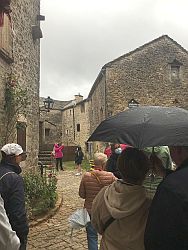 The third stop on our day trip to the Auvergne was the visit to “La Couvertoirade”. This ancient village, which today has only 190 inhabitants, is a historic, fortified Templar town dating back to the 12th century and is one of the most beautiful villages in France with its well-preserved buildings, fortified towers and town walls. The historical buildings of this village were explained to us at a guided tour. As a great way to end the day, some specialties from this region awaited us for dinner here in a rustic - only women-run - restaurant: Worth mentioning were Aligot (a special cheese-potato puree), and for dessert an amazingly delicious raspberry tart.
The third stop on our day trip to the Auvergne was the visit to “La Couvertoirade”. This ancient village, which today has only 190 inhabitants, is a historic, fortified Templar town dating back to the 12th century and is one of the most beautiful villages in France with its well-preserved buildings, fortified towers and town walls. The historical buildings of this village were explained to us at a guided tour. As a great way to end the day, some specialties from this region awaited us for dinner here in a rustic - only women-run - restaurant: Worth mentioning were Aligot (a special cheese-potato puree), and for dessert an amazingly delicious raspberry tart.
This first day was wonderful for all of us, but also exhausting due to the many different impressions. We were already very excited about the next day, when our language course would start.
Monday
We had our language classes in various classrooms in the city centre, including rooms at the Maison de Heidelberg. The Maison de Heidelberg is the German cultural centre in Montpellier. Centrally located within historic walls, it is the hub of Franco-German relations in the Languedoc region. Heidelberg has been twinned with Montpellier for almost 60 years.
Every morning we walked about 25 minutes from the hotel through the Antigone quarter to our classrooms. So we could admire part of Montpellier's great monumental buildings every day. From Monday to Friday our lessons lasted from 9 a.m. to 1 p.m. A total of 13 German-speaking and 7 Spanish twinners were divided into three different levels.
At the beginning of the language course, Madame Clare Hart, the representative of the city of Montpellier for European cultural relations, gave us a warm welcome and wished us all much success in our learning and a wonderful time in Montpellier.
Language classes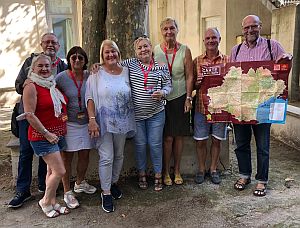 In the "Cours Débutant" (beginners' level), 4 German, 1 Danish and 2 Spanish twinners were familiarized with the French language by the very committed teacher Christiane. Right from the start, each of us had to introduce himself/herself in French to his neighbour with name, place of residence, place of birth, country of origin and marital status. To help there was Christiane’s introduction. Imitating the pronunciation was difficult at first. With a lot of humour and fun we learned every day - partly with the help of pictures - many French words of everyday life as well as important phrases. A great sense of achievement was also the implementation
In the "Cours Débutant" (beginners' level), 4 German, 1 Danish and 2 Spanish twinners were familiarized with the French language by the very committed teacher Christiane. Right from the start, each of us had to introduce himself/herself in French to his neighbour with name, place of residence, place of birth, country of origin and marital status. To help there was Christiane’s introduction. Imitating the pronunciation was difficult at first. With a lot of humour and fun we learned every day - partly with the help of pictures - many French words of everyday life as well as important phrases. A great sense of achievement was also the implementation 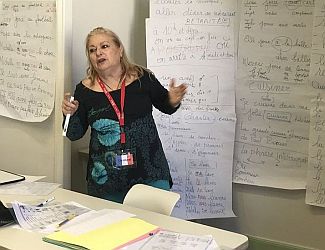 of what was learned in everyday life, e.g. ordering coffee and drinks during our breaks at the bistro, asking for the bill, giving a tip, etc. The numbers were spoken up and down, but it became difficult again with the times of the day. There was no homework, only at the end the task until next year: To work through all the written notes again every four weeks! Our "dream team" has already been reminded of this by Christiane via e-mail! (Michaela Alber)
of what was learned in everyday life, e.g. ordering coffee and drinks during our breaks at the bistro, asking for the bill, giving a tip, etc. The numbers were spoken up and down, but it became difficult again with the times of the day. There was no homework, only at the end the task until next year: To work through all the written notes again every four weeks! Our "dream team" has already been reminded of this by Christiane via e-mail! (Michaela Alber)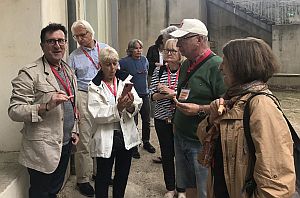 I was a student in the "Cours Intermédiaire" (Advanced) with Pierre-Yves Videlot as techer. Somehow it seemed to me that I knew the teacher’s name. I found the lessons very interesting and varied, also because they responded to the interests of the students. He was excellently prepared and carried out the lessons tightly. We did repetitions and practiced enough and the lessons with Pierre-Yves were fun.
I was a student in the "Cours Intermédiaire" (Advanced) with Pierre-Yves Videlot as techer. Somehow it seemed to me that I knew the teacher’s name. I found the lessons very interesting and varied, also because they responded to the interests of the students. He was excellently prepared and carried out the lessons tightly. We did repetitions and practiced enough and the lessons with Pierre-Yves were fun.
Unfortunately, the quality of the homework suffered from the intensive daily work programme, so it could only be done at midnight and mostly under the influence of a few glasses of vin rouge.
I would like my teacher to teach me again next year. (Peter Backes)
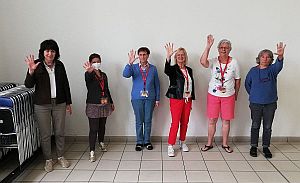 The "Cours Conversation" was led by our dynamic and very experienced teacher Jacques. By providing us with very current and scientific topics and texts, the level was immediately set quite high. For us 8 Germans and 1 Spaniard it was a good challenge on a linguistic level (grammar, special rules and text comprehension) in a pleasant atmosphere. For example, we discussed: Membership in Eurojumelages, climate change and its consequences, cultivation of algae and their advantages and disadvantages when consuming, modern aircraft construction with 6 wings and of course also about the cultural and culinary programme of the previous day. We are looking forward to seeing Jacques again. (Rita Caumettes)
The "Cours Conversation" was led by our dynamic and very experienced teacher Jacques. By providing us with very current and scientific topics and texts, the level was immediately set quite high. For us 8 Germans and 1 Spaniard it was a good challenge on a linguistic level (grammar, special rules and text comprehension) in a pleasant atmosphere. For example, we discussed: Membership in Eurojumelages, climate change and its consequences, cultivation of algae and their advantages and disadvantages when consuming, modern aircraft construction with 6 wings and of course also about the cultural and culinary programme of the previous day. We are looking forward to seeing Jacques again. (Rita Caumettes)
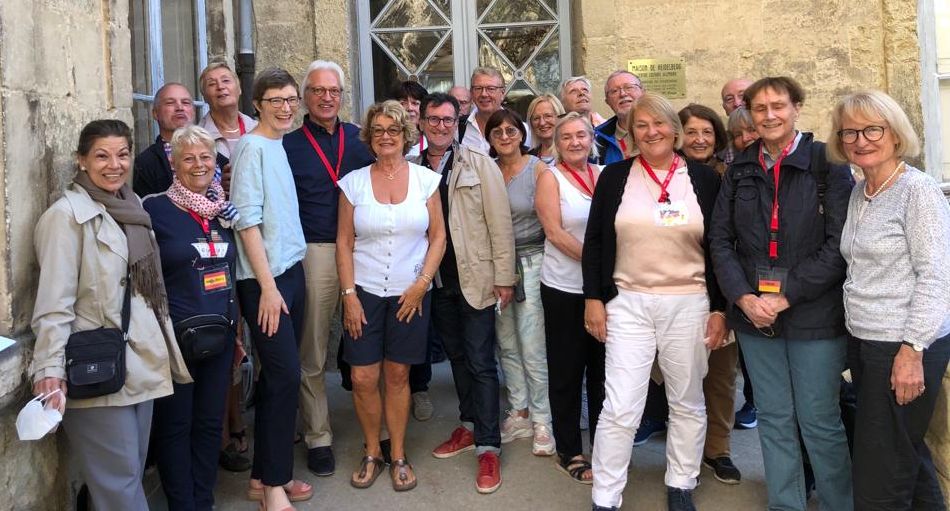
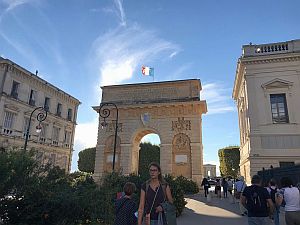 After a good lunch in the city, we got to know
After a good lunch in the city, we got to know 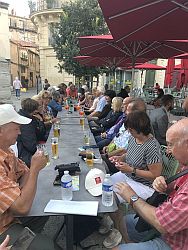 the city of Montpellier even better during a 3-hour walk accompanied by a city guide. Montpellier is a vibrant city on the French Mediterranean coast with around 300,000 inhabitants. Montpellier is one of the oldest university cities in France. We were surprised by the predominantly young population. Here, the Mediterranean way of life is clearly combined
the city of Montpellier even better during a 3-hour walk accompanied by a city guide. Montpellier is a vibrant city on the French Mediterranean coast with around 300,000 inhabitants. Montpellier is one of the oldest university cities in France. We were surprised by the predominantly young population. Here, the Mediterranean way of life is clearly combined 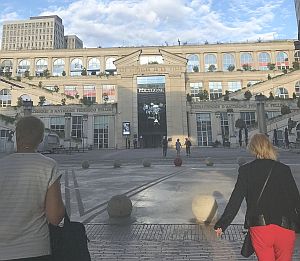 combined with a wide range of cultural activities. In the cityscape, magnificent historical buildings meet the most modern architecture. Everything appears clean and well maintained.
combined with a wide range of cultural activities. In the cityscape, magnificent historical buildings meet the most modern architecture. Everything appears clean and well maintained.
The centre of the city and the meeting point of the inhabitants is the Place de la Comédie with the Fountain of the Three Graces, the Opera Comédie, which was built in the 18th century and which gave the square its name, and other characteristic historical buildings. Narrow, medieval streets with town houses and many small, inviting shops, boutiques, bistros and restaurants, as well as open spaces in between,characterize 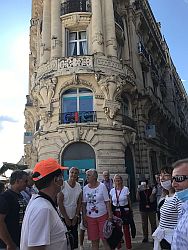 the town center. Visible from
the town center. Visible from 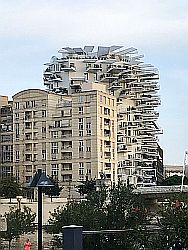 afar, at the end of a large street, is the triumphal arch Porte du Peyrou, built at the end of the 17th century on Montpellier's highest point in honour of Louis XIV. If you climb the triumphal arch, you have a fabulous panoramic view of the whole city from the top.
afar, at the end of a large street, is the triumphal arch Porte du Peyrou, built at the end of the 17th century on Montpellier's highest point in honour of Louis XIV. If you climb the triumphal arch, you have a fabulous panoramic view of the whole city from the top.
In the travel guide you can read that Montpellier is the fastest growing city in France, not least because of its high quality of life. The population has doubled since 1960.
Tuesday
For lunch we took the bus to Béziers to one of its most spectacular buildings, located at the foot of the city: the Canal du Midi and its 9 locks of Fonseranes (Les 9 ecluses de Fonseranes). In the cozy garden of a restaurant, the food tasted excellent again. Afterwards, we boarded a boat that took us along a stretch of the famous Canal du Midi. This canal extends for a total of 240 km and connects Toulouse with the Mediterranean Sea.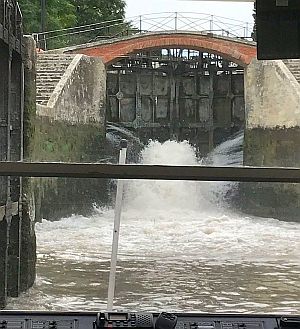 The Canal du Midi was built in the 17th century by Pierre-Paul Riquet, a son of the town of Béziers, under the reign of Louis XIV. A technical masterpiece at the time! Fascinating for us was also the canal bridge on which our boat sailed over the river Orb. The Canal du Midi has been a Unesco World Heritage Site since 1996, as have the 9 locks of Fonseranes, an impressive structure classified as a historic monument. We were able to experience a couple of these locks, which allow overcoming a height difference of 21.50 m over a length of 300 m.
The Canal du Midi was built in the 17th century by Pierre-Paul Riquet, a son of the town of Béziers, under the reign of Louis XIV. A technical masterpiece at the time! Fascinating for us was also the canal bridge on which our boat sailed over the river Orb. The Canal du Midi has been a Unesco World Heritage Site since 1996, as have the 9 locks of Fonseranes, an impressive structure classified as a historic monument. We were able to experience a couple of these locks, which allow overcoming a height difference of 21.50 m over a length of 300 m.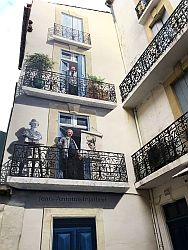 Travelling on the 20 to 24 m wide canal in a rented houseboat means for many tourists a special Mediterranean atmosphere, exploring the Camarque and experiencing the sights of southern France at first hand. This probably brings you closer to the French way of life.
Travelling on the 20 to 24 m wide canal in a rented houseboat means for many tourists a special Mediterranean atmosphere, exploring the Camarque and experiencing the sights of southern France at first hand. This probably brings you closer to the French way of life. 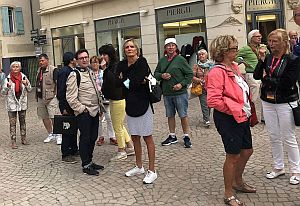 A city guide led us through a landscape park in Béziers with a large fountain by the sculptor Injalbert and many busts of Occitan poets. We walked through the old town from the town hall through winding alleys to Saint Nazaire Cathedral. Impressive were the deceptively real-looking but painted facade balconies with people. From the forecourt of the cathedral you had a great view over Béziers, the Canal du Midi and the landscape.
A city guide led us through a landscape park in Béziers with a large fountain by the sculptor Injalbert and many busts of Occitan poets. We walked through the old town from the town hall through winding alleys to Saint Nazaire Cathedral. Impressive were the deceptively real-looking but painted facade balconies with people. From the forecourt of the cathedral you had a great view over Béziers, the Canal du Midi and the landscape.
Wednesday
In the afternoon we went by bus to Marseillan to the lagoon of Thau ("Etang de Thau"). There we boarded a boat to get to know the lagoon better, which is 22 km long, 5 km wide and 4 m deep. The Canal du Midi also flows into this lagoon. Four fairways connect the lagoon with the sea. Otherwise, the lagoon is closed all around, which means it is saltier than the sea. In this lagoon, in addition to an abundance of fish, there are also 2800 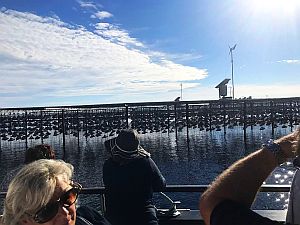 oyster beds, which the shellfish farmers call "tables". All tables are each 50 m long and 10 m wide. About 1000 lines are hung in the water on a table, the oysters grow on these lines. Each table results in an average production of 8 to 10 tons of oysters every 2 years. The canisters around the tables are nets to protect the oysters from bream (predators). The solar panels and wind turbines above the tables generate the energy needed to lift the oyster ropes out of the water, thus creating an artificial "escape" for the oysters. This procedure makes the oysters more robust for transport, because when the oysters leave the water they feel in danger and create an extra nacre that strengthens their shells.
oyster beds, which the shellfish farmers call "tables". All tables are each 50 m long and 10 m wide. About 1000 lines are hung in the water on a table, the oysters grow on these lines. Each table results in an average production of 8 to 10 tons of oysters every 2 years. The canisters around the tables are nets to protect the oysters from bream (predators). The solar panels and wind turbines above the tables generate the energy needed to lift the oyster ropes out of the water, thus creating an artificial "escape" for the oysters. This procedure makes the oysters more robust for transport, because when the oysters leave the water they feel in danger and create an extra nacre that strengthens their shells.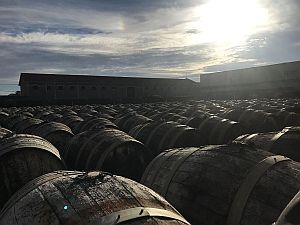 After the boat trip, we took part in a guided tour in Marseillan with extensive
After the boat trip, we took part in a guided tour in Marseillan with extensive 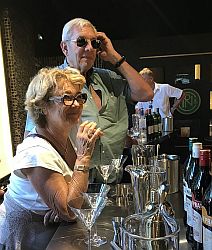 tasting of the famous vermouth Noilly Prat. This vermouth, appreciated by gourmets, is made according to a secret preparation. The wines are stored in the cellars for months and then outdoors for a year. The aromatic strong flavour of the vermouth comes from the slow aromatisation with many different herbs from five continents. During the tasting we were able to try the different flavors of the different types of vermouth. A special highlight of that afternoon was that we were able to make our own cocktail from vermouth, gin or vodka and other ingredients such as syrup,
tasting of the famous vermouth Noilly Prat. This vermouth, appreciated by gourmets, is made according to a secret preparation. The wines are stored in the cellars for months and then outdoors for a year. The aromatic strong flavour of the vermouth comes from the slow aromatisation with many different herbs from five continents. During the tasting we were able to try the different flavors of the different types of vermouth. A special highlight of that afternoon was that we were able to make our own cocktail from vermouth, gin or vodka and other ingredients such as syrup, 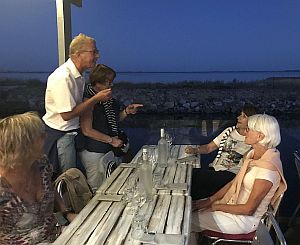 lemon, olives and ice. It was simply delicious to enjoy this
lemon, olives and ice. It was simply delicious to enjoy this 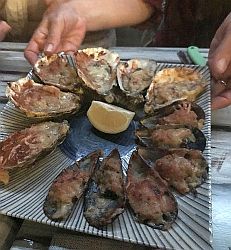 lemon, olives and ice. It was simply delicious to enjoy this self-mixed cocktail as an aperitif in the garden of Noilly Prat under the olive trees!
lemon, olives and ice. It was simply delicious to enjoy this self-mixed cocktail as an aperitif in the garden of Noilly Prat under the olive trees!
In a cheerful mood we then went for dinner to a restaurant directly on the water of the lagoon, where we were served delicious gratinated oysters and mussels. The beautiful ambience was crowned by a fantastic red full moon rising and its reflection in the water.
Thursday
Thursday afternoon was “free” for everyone. We were looking forward to the evening, the "Soiree Amicale", which was to take place in the Corum, the cultural centre of the city of Montpellier, in the Salon Belvédère. The evening began with a champagne reception and small canapés 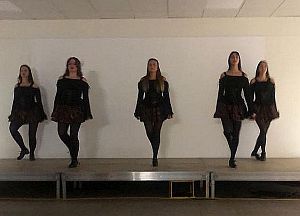 outside, framed by a great view of Montpellier. All language course participants, French twinners and invited guests had come in festive clothing to this special evening and took their seats at the assigned tables.
outside, framed by a great view of Montpellier. All language course participants, French twinners and invited guests had come in festive clothing to this special evening and took their seats at the assigned tables.
The tap dance group "Footloose" performed Celtic Irish dances at the beginning with a breathtaking technique. 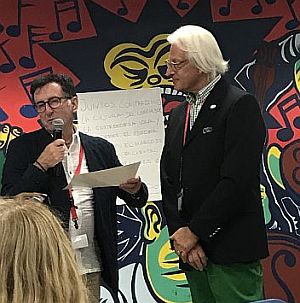 After this musical feast for the eyes, we were served the delicious three-course celebratory meal. Afterwards, the language course participants each received their "diploma" for the respective language course from their teachers with personal words.
After this musical feast for the eyes, we were served the delicious three-course celebratory meal. Afterwards, the language course participants each received their "diploma" for the respective language course from their teachers with personal words. 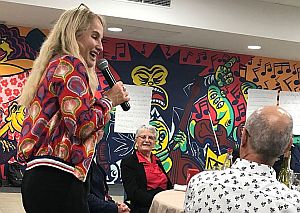 Madame Clare Hart, who had already welcomed us on Monday, and Carmen Cabrol (former President of the Jumelages Narbonne) spoke words of greeting. Peter Backes (chairman of Eurojumelages) thanked the teachers Christiane, Pierre-Yves and Jacques and especially Marie-Hélène for her organization and gave them presents.
Madame Clare Hart, who had already welcomed us on Monday, and Carmen Cabrol (former President of the Jumelages Narbonne) spoke words of greeting. Peter Backes (chairman of Eurojumelages) thanked the teachers Christiane, Pierre-Yves and Jacques and especially Marie-Hélène for her organization and gave them presents.
Friday
After the last language class morning, it was time to say goodbye to our great teachers and we are already looking forward to seeing them again at the next language course in 2022.
In the afternoon we drove in several private cars of the French twinners through the wild and romantic landscape of the Camargue to Carnon, which is situated directly at the sea. A Moroccan menu with chicken from the Tanjine awaited us. Afterwards, some finally had the opportunity to take a bath in the sea. Others, meanwhile, visited the cute little town of Aigues-Mortes.
In the evening we all met again in a cozy restaurant at the river Lez. It turned out that the German, Spanish and French twinners have grown closer together during this week through learning and experiencing together and that new friendships had been formed. It was hard to say goodbye,....... but there is the possibility of taking part in another French language course again or other Eurojumelages activities next year!
Finally, a few words about the culinary pampering programme: Every day, in the afternoon and in the evening, Marie-Hélène guided us through traditional Mediterranean cuisine in selected restaurants. Every time we experienced a culinary delight. For the agricultural diversity of the Midi-Languedoc offers products from high-quality sea fish, crustaceans, cattle, sheep, goats and products from fruit and wine-growing. We could enjoy all of it. It was "living like God in France".
UN GRAND MERCI à Marie-Hélène et son équipe
Au revoir et à bientôt
Michaela Alber, Sektion Böblingen/Tübingen and Rita Caumettes, Sektion Stuttgart, GERMANY


